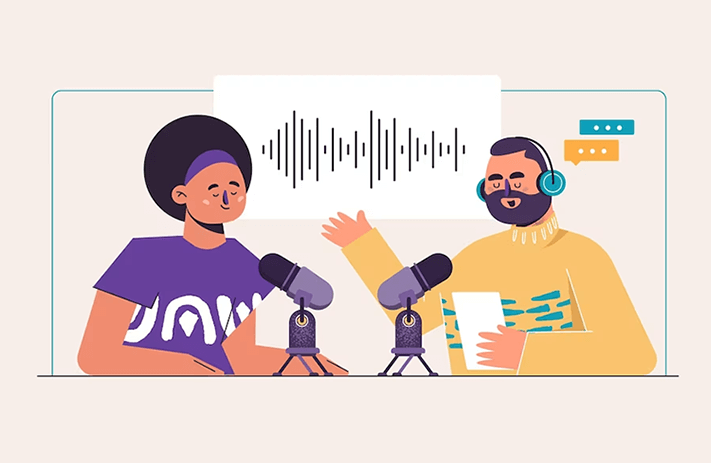
Click the button to start reading
A Simple Guide to Assertiveness in the Workplace
None of us likes to be unheard or dismissed at work—to have our views undermined and brushed off. Unfortunately, that’s the case for lots of people in the modern workplace. On the bright side, changing the way your colleagues treat you isn’t really that complicated—a little assertiveness will definitely improve things.
Learning to stand up for yourself and be more assertive are essential skills that will help you become more confident, which, as a result, will fast-track you for promotion and greater self-esteem.
In this blog post, we’ll explore what assertiveness is, why it’s useful, and what you should do to become a more determined worker.
Let’s dive right in, shall we?

What does it mean to be assertive?
Fundamentally, being assertive means that you’re prepared to stand up for the things you consider right while also being calm, composed, and polite.
Unfortunately, not all of us are born or raised to be assertive, but the good part is that this is a trainable skill—and a very important one, too, especially at work.
The function of assertiveness is to defend your boundaries and have control over how others interact with you.
Imagine being called out for a mistake you’ve made in a meeting—it’s definitely something neither of us would like to experience. Being assertive isn’t about denying that you’ve made a mistake or calling the person that called you out a jerk for doing so. The main idea here is to privately and politely ask them to raise issues with you in person instead of penalizing you in front of a large group of people.
Assertiveness ≠ being a jerk
Finding the middle ground between assertiveness and aggression can be demanding at first. If you happen to be a person that isn’t as confident when it comes to standing your ground, it may take a while till you find the right balance—and that’s totally okay. Mindfulness is key here.
Actually, let’s explore the difference between aggression and assertiveness.
- Assertiveness is all about your rights and the rights of others. The point here is to be straightforward and honest about the things you want while also taking into account the rights and needs of the people that surround you. An assertive person aims to communicate their preferences in a firm and respectful manner.
- Being aggressive is about being “right” and disregarding the needs and feelings of the people around you. It has little to do with expressing your preferences. Instead, the focus is on getting people to do what you want.
Picture this: Your boss approaches you at the end of your workday before you go on vacation. They give you an urgent task and tell you that it should be delivered ASAP. You’re in a situation where you can be passive, aggressive, or assertive.
Clearly, this is a situation where you’re forced to do something at an inappropriate time with pretty much no regard for your comfort. You could either choose to accept the assignment despite it interfering with your plans or politely let them know that the task at hand will be delivered once you’re back from your vacation. This way, you acknowledge the importance of the assignment, but on your own terms.

The value of assertiveness
Aside from providing you with more control over your life at work and outside of it, assertiveness also makes a person generally more confident. Think of it this way—an assertive person is typically prepared to handle any conflict that comes their way at work.
As good as that may seem, the path to becoming more assertive doesn’t necessarily start at the things that a person needs to learn. Instead, it’s the things that they have to unlearn.
Below, you’ll find a list of obstacles that prevent people from being assertive at work:
- Not knowing what you really want.
- Lacking clarity in terms of your emotions and mistaking genuine disagreement for anger or aggression.
- You feel like your needs aren’t that important.
- You strive to be liked by everyone at all costs.
- You get flustered in uncomfortable situations.
- You feel like your skillset is inferior to your peers’.
- You’ve been criticized way too much in the past.
- You’re afraid that you’ll push people away by disagreeing with them.
- You suffer from impostor syndrome.
- You’re scared of being challenged.
- You’re afraid that the person that you disagree with will retaliate.
Take a look at some of the blockers above and identify whether one of some of them might be true for you. The path to assertiveness starts with being aware of obstacles you’re facing on a daily basis and will allow you to better differentiate between assertiveness and aggressiveness.
By gradually becoming more confident and aware of your wants and needs you’ll be able to:
- Experience an increase in self-esteem and self-respect.
- Tackle conflicts with more confidence.
- Satisfy your needs without disregarding the needs of others.
- Make better and quicker decisions.
- Become a better mediator and negotiator.
- Develop leadership skills.
Learning to be assertive in the workplace will definitely benefit your interactions outside work. Many of us find saying “no” extremely complicated to people—and unfortunately, the so-called “yes syndrome” harms our colleagues along with ourselves. This is why it’s critical to learn to refuse people’s requests and accept that saying “no” isn’t a sign of weakness.
Consequently, failing to learn to be assertive can lead to decreased productivity, harmed relationships, and increased chance of burning out.

A path to assertive behavior
What can assertive behavior look like in the workplace? Let’s explore five examples so that you can learn how to be assertive at work.
1. Be honest
An essential component of assertive behavior is honesty. Being able to communicate how you feel in a straightforward manner in a respectful way is the first step towards confidence in the workplace.
Imagine that the company you work in has rolled out a new set of rules or requirements that you strongly disagree with. As a member of the company’s workforce, you’re entitled to let them know that you have reservations regarding the changes they’re about to roll out.
It’s important to pack your dissent with strong arguments in order for it to be received constructively. Not only will this help you communicate how you feel about the issue at hand, but it will also emphasize your critical thinking and problem-solving skills, which will, as a result, make it more complicated to simply dismiss your standpoint on the matter.
2. Gaze confidently
Eye contact is mysterious—it has a very powerful effect on humans. Typically, eye contact is a display of confidence. On the other hand, avoiding it suggests that you’re looking to avoid confrontation, which can invite some people to take advantage of that.
Looking people in the eye is also very useful because it triggers a heightened sense of self-consciousness in them—they immediately become more aware of the situation they’re in, as well as understand how their interlocutors feel.
Research has shown this by requesting that the participants of the study describe their reactions to a variety of images, both pleasant and unpleasant. The interesting part of the research design is that some of the images were preceded by pictures of people, some that make direct eye contact, others looking away. Researchers found that people typically have a stronger bodily response to images when they’re subjected to another person’s gaze.
Therefore, it’s safe to say that when people make eye contact, both parties experience a heightened sense of awareness of both their feelings and the situation. Politely rejecting someone’s request while also looking them in the eye will help you communicate your feelings more effectively.

3. Take personal responsibility
Assertiveness allows us to establish boundaries and communicate our preferences and feelings. However, there’s another side to this coin—taking responsibility when you make mistakes.
Sometimes, when we choose to stand our ground, we read the situation incorrectly, and we make choices that weren’t properly calculated, and that’s totally fine. To err is human. However, it’s critical in such situations to acknowledge your mistakes. Holding others accountable means that we should hold ourselves accountable as well.
4. Get everyone to agree
As we mentioned above, assertiveness isn’t just about being right or winning in a particular situation. Instead, it’s a behavior that helps you underline your wants and needs and find an amicable solution to a problem. Therefore, whenever you choose to stand your ground on a certain topic, make sure that the people involved agree with your decision because your choice affects them as well.
5. Think beyond yourself
Being assertive doesn’t mean that you should also be self-centered. Making confident decisions about what you think is better means that you have to balance what you think is good for yourself and the collective that you’re a part of.
In order to become an assertive person, you should take pride in what you do, but also what your coworkers do as a team.

A practical guide to assertiveness
Now that we’ve explored some of the things that will help us become more assertive, it’s time to take a closer look at some practical steps we can take to stand our ground in a confident and convincing manner.
Express how you feel
It’s complicated to get your point across if you don’t explain how certain situations make you feel. Let’s go back to our previous example where your boss asks you to deliver a huge task hours before you leave on vacation. Imagine standing your ground in this situation without telling them how this decision affects your quality of life—that wouldn’t be really productive.
Of course, you can say something along the lines of: “This is insane, I can’t do this now,” or, “Do you seriously expect me to do this,” but it’s safe to say that it wouldn’t take you anywhere and would only harm your relationship with your manager.
Instead, consider saying: “I’m afraid I won’t be able to handle this amount of work in such a short time. But I’ll make sure to have it done when I’m back.” Doing so in a poised and confident manner will most likely allow your boss to empathize with your situation by understanding your perspective.
Using “I” statements is also very useful when trying to avoid putting the blame on someone else. Assertive people don’t point fingers. They communicate their point of view.
Think of a situation where a colleague of yours uses something that belongs to you without your consent, like a coffee mug, for instance. Instead of saying: “Have you ever considered buying your own coffee mug,” tell them how you feel about it—something along the lines of: “I feel really uncomfortable that you’re using my cup.”
Let your body speak
Body language is an invaluable tool in communication. It helps people decode what the other person is saying with a greater degree of confidence. Similarly, it enables us to interpret other people’s moods and feelings.
To be assertive, we need to make use of body language to accentuate our confidence. Here are a few simple tips to help you get your point across:
- A confident posture starts with your feet—plant them in an open, wide stance.
- Keep your chin and head up.
- If you’re standing, stand straight.
- Keep your hands out of your pocket.
- Maintain eye contact.

Saying “no” is an immutable right
It can be hard to say “no.” We often associate it with disappointing people, making them uncomfortable and unhappy, but that’s not necessarily true. The crucial part is how you deliver it—and sometimes, being straightforward is the way to go.
Imagine being asked to come in on a Saturday without being paid extra. The briefer and the more honest you are, the more confident the message is going to be. Instead of saying: “I’m not sure I’ll be able to,” consider saying: “No. I really don’t think that’s fair.”
Practice makes perfect
Many of us know what it means to be assertive. It’s not like everyone’s been hiding it from us our entire lives. Not everyone is confident enough by default. On the bright side, it’s a skill you can learn pretty quickly.
Practice assertive behavior alone in front of the mirror or with a friend. This will allow you to quickly learn to be straightforward and honest in conversations.
Keep your emotions in check
At first, it might be complicated to find the right emotional balance when being assertive at work, and that’s to be expected. When we learn to behave in a new way, things might not go as smoothly as we might expect them to, but that’s a crucial part of the path.
During these interactions, it’s essential to keep in mind that these are “inter-actions,” meaning that there are two parties in this dialogue. Speak your mind, but also make sure you listen to the person you’re communicating with.
The best way to ensure that is to remain mindful of the conversation and not let feelings get the best of you. During complicated conversations, we can often experience a wide array of negative emotions like anger or annoyance—but rest assured, these are never productive. Whenever you feel frustrated, take a second to contemplate the fact that you’re frustrated, think about the most appropriate answer and then proceed with communicating it.
Assertiveness isn’t about control
We mentioned above that assertive behavior is, first and foremost, a means to communicate how you feel and make sure that your opinion is taken into account and respected. This, however, does not entail manipulating others.

Positive mental attitude
A very useful little trick to keep in mind when practicing assertive communication is sticking to positive sentences. Framing a sentence in a polite yet straightforward manner will prevent you from delving into aggression territory.
It’s absolutely vital to treat people with respect, even if they ask you to “come in on Saturday” without being paid for your extra hours. This will allow you to navigate complicated and unpleasant situations gracefully.
Start small
It’s always a good idea to practice assertive behavior in less risky situations and environments. Starting with your manager or CEO may not be the best call. However, you can always practice with people that are close to you, a significant other or a friend.
You also don’t have to stand your ground on important subjects, for instance choosing a place to have dinner or coffee is a good start.
The semantics of confidence
We discussed how we should communicate in an assertive manner. We’ve also touched on your posture and body language and how they help you appear assertive. However, we should also bear in mind that there are many words in our vocabularies that affect how the things we say are perceived.
For instance, think of the word “just.” We use it a lot, but it also injects an element of uncertainty into a person’s discourse. “I just thought that” or “I was just wondering” are both equally safe and polite expressions to use, but the word “just” make them appear a bit insecure—which is something we want to avoid during assertive communication because it may look like we’re looking for confirmation.
It’s also important to pay close attention to your tone when communicating assertively. Typically, people raise their intonation at the end of a question. However, people often do that with declarative sentences when they seek the approval of the people they’re interacting with.
The bottom line
Assertiveness can help you meet your wants and needs so you can be happier in your workplace.
It can also help you gain the respect of your peers and move forward in your career.
















